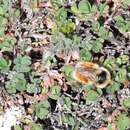pt-BR
nomes no trilho de navegação


Bombus sylvicola is a species of bumblebee native to North America. It occurs throughout most of Canada, its distribution extending into Alaska and the western contiguous United States.[2] In the southernmost extent of its range in California it occurs only at elevation.[1] It is known commonly as the forest bumblebee.[1]
This is a common species.[2] It is a bee of alpine and subarctic climates. It lives in open, grassy habitat such as mountain meadows. It nests underground, or sometimes on the surface. Its food plants include sandworts, rabbitbrush, fireweeds, lupines, coyote mints, butterburs, mountain heathers, and groundsels.[1]
This was one of two bees featured in a study showing how climate change may be affecting their morphology. This species is polymorphic, with longer-tongued and shorter-tongued individuals. As the current climate change progresses, longer-tongued individuals are becoming less common in the population because flowers with long corollas are becoming less abundant. Shorter-tongued bees are having more success as generalist foragers among the available flora.[3]
This species is very similar to the black-tailed bumblebee (B. melanopygus), the two sometimes having nearly identical color patterns.[4]
Bombus sylvicola is a species of bumblebee native to North America. It occurs throughout most of Canada, its distribution extending into Alaska and the western contiguous United States. In the southernmost extent of its range in California it occurs only at elevation. It is known commonly as the forest bumblebee.
This is a common species. It is a bee of alpine and subarctic climates. It lives in open, grassy habitat such as mountain meadows. It nests underground, or sometimes on the surface. Its food plants include sandworts, rabbitbrush, fireweeds, lupines, coyote mints, butterburs, mountain heathers, and groundsels.
This was one of two bees featured in a study showing how climate change may be affecting their morphology. This species is polymorphic, with longer-tongued and shorter-tongued individuals. As the current climate change progresses, longer-tongued individuals are becoming less common in the population because flowers with long corollas are becoming less abundant. Shorter-tongued bees are having more success as generalist foragers among the available flora.
This species is very similar to the black-tailed bumblebee (B. melanopygus), the two sometimes having nearly identical color patterns.
Bombus sylvicola is een vliesvleugelig insect uit de familie bijen en hommels (Apidae). De wetenschappelijke naam van de soort is voor het eerst geldig gepubliceerd in 1837 door Kirby.[1]
Bronnen, noten en/of referentiesBombus sylvicola (saknar svenskt namn) är en insekt i överfamiljen bin (Apoidea) och släktet humlor (Bombus) som finns i Nordamerika.
Humlan, som har en medellång tunga[3], är övervägande gulpälsad med en svart fläck på mellankroppen mellan vingfästena. De två första och de två näst sista segmenten på bakkroppen är gula, och bakkroppsspetsen är svart. För bakkroppssegment 3 och 4 finns det två färgvarieteter: En som främst finns i Kaskadbergen och Sierra Nevada, där vanligtvis dessa segment är svarta med få eller inga gula hår, och en som har segmenten orangeröda. Honorna har dessutom svart ansikte, till skillnad från hanarna som har gult.[4] [5].
De övervintrande drottningarna kommer fram i början av juni, arbetarna i slutet av juni och hanarna i början av juli. I slutet av september – början av oktober upplöses kolonierna och alla djuren dör, utom de nya drottningarna som övervintrar i jorden. Bombus sylvicola samlar nektar och pollen från ett flertal växtfamiljer, främst från familjerna korgblommiga växter (som korsörter och Raillardella[3]) och ärtväxter (som lupiner och sötväpplingar[3]). Den är framför allt en bergslevande art som kan gå upp till över 4 200 meters höjd i bergen.[4]
Bombus sylvicola finns i västra Nordamerika från Alaska och Newfoundland söderut via Kaskadbergen, Sierra Nevada och Klippiga bergen, Kalifornien, Utah, Nevada[4] till New Mexico.[5] Den har även påträffats i östra Nordamerika, Ontario (1958), nordvästra Québec, Labrador och North Carolina (1935).[6] Arten är ingenstans vanlig.[3]
Bombus sylvicola (saknar svenskt namn) är en insekt i överfamiljen bin (Apoidea) och släktet humlor (Bombus) som finns i Nordamerika.
Bombus sylvicola là một loài Hymenoptera trong họ Apidae. Loài này được Kirby mô tả khoa học năm 1837.[2]
Bombus sylvicola là một loài Hymenoptera trong họ Apidae. Loài này được Kirby mô tả khoa học năm 1837.